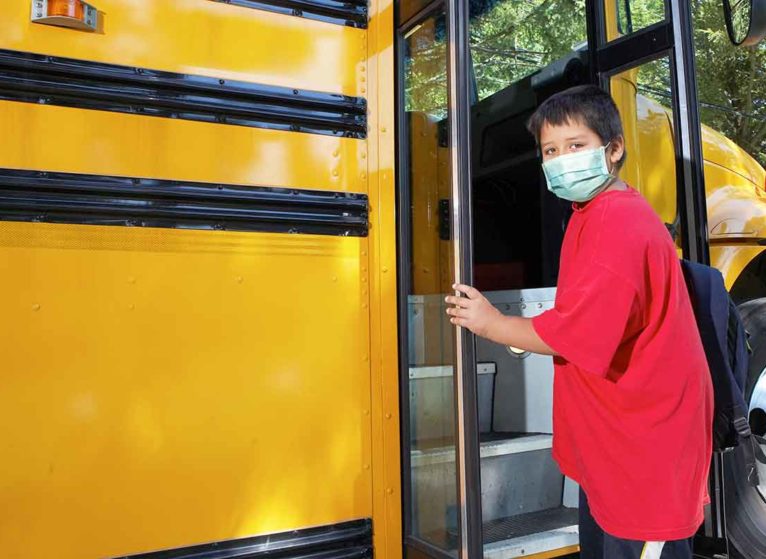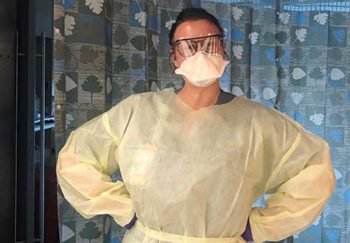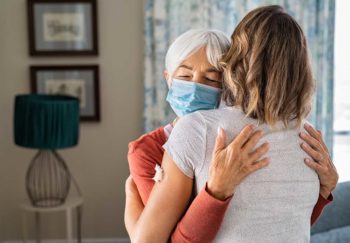Nationally, the debate on the upcoming school year continues. Politicians and pundits are debating policies, procedures, and funding. Some are urging in-person, while others appeal for all virtual.
Meanwhile, parents, teachers and school administrators are left considering how kids can safety return to learning during the coronavirus pandemic.
The Centers for Disease Control’s guidelines include:
- Discouraging sharing school supplies and electronic devices that are difficult to clean and disinfect
- Placing desks 6 feet apart when feasible
- Having students wear masks in some circumstances
- Minimizing the number of kids on buses
Most agree a one-size-fits-all approach is not appropriate for return to school decisions.
Virtual Learning & A Safe Return to School
I had so many questions around whether it’s safe for kids to go back to school. I turned to three UVA doctors — infectious diseases expert Taison Bell and pediatricians Susan Gray and John Olsson — for answers.
Are kids less likely to get sick from COVID-19?
According to the CDC, most known cases have been in adults. However, there is still important information to know when it comes to coronavirus and children. In the U.S. and other countries, only around 2% of diagnosed cases are in kids, Bell says. But he adds that children — who generally have milder symptoms — are less likely to be tested. Most of that data came after countries had already closed schools.
“The great majority of children and teenagers, even if they get COVID, are going to be just fine,” Gray says. “The people who are going to be most at risk are going to be teachers and staff.”
She adds that there are two concerns:
- Kids with chronic conditions like diabetes are more likely to have complications.
- Kids can get multisystem inflammatory syndrome (MIS-C), a very serious condition where different organs become inflamed.
“For parents, that is a small but frightening risk,” Gray says.
What about transmission? Are kids less likely to spread coronavirus?
“Nobody really knows for sure,” Olsson says. “There have been studies from some of the European countries that suggest kids are less likely to spread coronavirus, but there also have been some observations in the United States that kids can.”
Bell says, “This is evolving data, but it does appear from what we know so far that children seem to be less of a driver for transmission than adults are.” However, he adds that this only applies to younger kids — kids are in high school seem to be closer to adults in their ability to spread the virus.
How risky, in terms of coronavirus transmission, is in-person school for teachers and other adults in the building?
This largely depends on several factors:
- The area’s case rate
- Your age — older adults are at the highest risk for severe illness
- Whether you have certain underlying medical conditions
- How closely schools can follow infection control guidelines, such as wearing masks and keeping people physically apart
Are there risks if kids do 100% virtual learning?
All three doctors stressed that beyond education, schools are a social safety net. While some of those services may translate virtually — online counseling, for example — others will require some creative problem-solving.
Food Security
Kids who receive free or reduced-price school meals may not get enough to eat at home. Charlottesville and Albemarle County have addressed this by delivering food to communities.
“They’ve done a remarkable job of keeping that up over the summer,” Gray says. “But any plan for online school anywhere in this country needs to include a plan for making sure food goes to children.”
Teachers Look Out for Students
In these stressful times, kids are more likely to witness or be victims of domestic abuse. In-person school can be a safe escape. “There’s just no substitute for having someone lay eyes on them who knows them,” Gray says.
Not Every Parent Can Stay Home
Trying to work from home and help kids with virtual school at the same time is challenging, to say the least. Parents are experiencing skyrocketing stress and less sleep. And parents who can’t work remotely face a huge stressor: What if they can’t find or afford safe and reliable childcare?
Even if schools can re-open relatively safely, this is still an issue. Bell stresses that it’s more essential than ever for kids to stay home if they’re sick. For younger kids, that may mean a parent has to take time off work.
Are kids otherwise doing OK with virtual learning?
Gray, who primarily sees teenagers, says, “I think my patients would tell you that yes, there’s a big difference” between virtual and in-person learning. Her patients have a hard time paying attention and fight Zoom fatigue.
On the plus side, kids who tend to oversleep and be late for school are doing better with later starts and no travel time.
“But for more kids, I would say, they’re really missing being with their friends physically,” Gray says. “The social isolation has been hard.”
Olsson points out that people, in general, thrive on interaction, and it’s difficult to replicate this virtually. “You can’t possibly have the type of interaction on Zoom that you would have by being in the same room,” he says. “We know that from teaching medical students and residents.”
In an in-person setting, he adds, kids also tend to get physical activity when they’re interacting with other kids. And they grow from interacting with others who come from different racial and ethnic or socioeconomic backgrounds.
What can parents do to help their kids with virtual learning and social isolation?
Gray says that among her teenage patients, those who have found new hobbies and projects are coping better. But she worries that they’re spending too much time on social media.
Additionally, some kids are staying up into the wee hours of the morning and sleeping for much of the day. This “vampire effect” can worsen feelings of social isolation, she says.
She and Olsson offer a few recommendations for parents:
Emphasize Screen-Free and Outdoor Time
Outside of schoolwork, kids should prioritize going outside, exercise, and getting good sleep. Adjust screen time around those activities, rather than making it the first priority.
Watch for Signs of Depression
Depressed teens don’t necessarily seem sad, Gray says. Rather, they might say they don’t care about anything or withdraw from people and activities.
In younger kids, tantrums or defiance might also be depression symptoms, Olsson says.
Talk to your child’s healthcare provider if you see these changes. Virtual therapy may be an option.
Parents, Take Care of Yourselves
You don’t want to dump your stress on your kids. But letting them know that you’re feeling stressed, angry or scared helps them understand that their feelings are normal, too, Olsson explains.
What are the most meaningful steps schools can take to reduce the spread of virus in an in-person setting?
Bell emphasized:
- Physical distancing. That means avoiding tight classrooms and keeping class sizes small.
- Face coverings at all times. Kids with autism or other sensory issues may not be able to tolerate a mask and will need an alternative or virtual option.
- Testing and screening. Schools should check temperatures and symptoms. Sick kids and adults need to stay home.
So, what should schools do this fall?
There are no easy answers.
Bell, Olsson and Gray emphasized that teachers, parents, school administrators, and health experts need to come together and have ongoing, open conversations about what’s best for their local community. They also stressed the importance of options; a child or teacher with chronic conditions may need to avoid in-person settings entirely.
Expert Care for Your Kids
Our pediatricians can help you and your kids get through the coronavirus pandemic.
Bell, who has a 6-year-old son, says he likes the flexibility of hybrid models that mix both in-person and virtual learning. If cases rise, school systems can more easily shift to all-virtual learning and vice versa.
He points out that communities have to think about all aspects — from what you do for a child with autism who can’t tolerate a mask, to taking care of the children of essential employees who can’t be home alone — for any plan they implement.
“It’s far better that we think about them in advance than scramble at the end,” he says. “It’s more dangerous when we scramble.”



If the children can’t physically go back to school because of the pandemic and the teachers don’t want to teach in the classrooms with the children because of the pandemic. Is it possible to have the teachers show up in their classrooms without the children, conduct lesson plans and books with assignments each day or week and send the books w/assignments out to the parents by school bus with probably an extra person on the bus to deliver the assignments each week?
And for each week that assignments are delivered; the completed assignments from prior week will be picked up by the person/school bus and transported to the school.
This will require a lot of organizational skills.
But it is an idea.